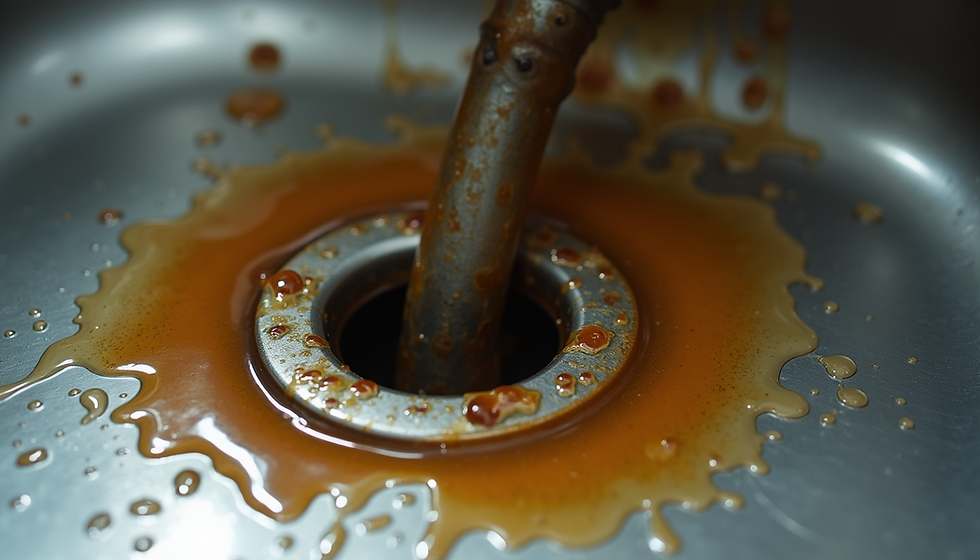How to Plumb a Kitchen Sink
- Jayant Upadhyay
- Apr 18
- 4 min read

Plumbing a kitchen sink can feel overwhelming, but it doesn't have to be. With careful preparation and a bit of know-how, you can set up your sink securely and efficiently. Whether you're replacing an old one or installing a brand new fixture, a clear understanding of the plumbing process is crucial for a smooth kitchen experience. In this guide, we'll break down each step, supplying you with enough detail to not only complete the task successfully but also troubleshoot common issues that may arise.
Essential Preparations Before You Start
Before jumping into plumbing, it is important to gather the right tools and materials to ensure a successful installation. Here’s what you will need:
Tools to Gather:
Adjustable wrench
Pipe cutter
Plumber's tape
Flathead and Phillips screwdrivers
Pliers
Bucket or towels (to catch spills)
P-trap kit
Flexible supply lines
Sink drain assembly
Silicone sealant
Necessary Materials:
As you collect your materials, make sure all components are compatible with your new sink and your existing plumbing systems. If you have any doubts about compatibility, consult a plumbing professional or refer to the manufacturer’s guidelines.
Step-by-Step Instructions for Plumbing a Kitchen Sink
Step 1: Turn Off the Water Supply
Before starting any plumbing work, shut off the water supply. Locate the shut-off valves under the sink and turn them clockwise to stop the water flow.
Always run the faucet to relieve pressure and drain any remaining water before proceeding.
Step 2: Remove the Old Sink (If Necessary)
If you are replacing an existing sink, the first task is to disconnect it. Start by detaching the supply lines from the faucet using the adjustable wrench, and be sure to place a bucket beneath to catch any water that might spill.
After that, unscrew the drain by removing the trap, which is the curved pipe beneath the sink. Lift out the old sink carefully from the countertop.

Step 3: Set Up the New Sink
If you are installing a new sink, first make sure it fits in the countertop opening correctly. Apply a bead of silicone sealant around the sink cutout, then gently position the new sink into the opening.
Check that the sink is centered and level before moving on to installation.
Step 4: Install the Faucet and Drain Assembly
Now it’s time to install the faucet and the drain assembly. Follow the instructions that come with your specific faucet model. Place the faucet in its designated hole and secure it using the nuts provided.
Next, attach the drain assembly. Insert the drain flange into the sink's designated hole, ensuring a tight seal with the rubber washer that comes with it. If necessary, you can use plumber’s putty for an extra layer of sealing.
Step 5: Attach the P-Trap
The P-trap is crucial for preventing sewer gases from entering your home. Connect the P-trap to the sink drain and the wall pipe as follows:
Secure the P-trap to the drain assembly using the provided nuts.
Fit the other end of the P-trap to the pipe coming from the wall. Adjust and tighten all joints to ensure a snug fit with no leaks.

Step 6: Connect the Water Supply Lines
Next, you will connect the water supply lines:
Attach the flexible supply lines to the shut-off valves by turning them clockwise.
Connect the other ends of the supply lines to your faucet.
Double-check that all connections are tight to avoid any leaks.
Step 7: Check for Leaks
Once everything is connected, it’s time for a quick test. Slowly turn on the shut-off valves and watch for leaks around the P-trap and faucet connections.
If you spot a leak, tighten the fittings with a wrench, but be careful not to over-tighten, as this can damage the components.
Step 8: Finishing Up and Cleaning
After confirming there are no leaks, check that the faucet runs smoothly and the water drains properly. Make any final adjustments as needed.
Finally, tidy up the work area, removing excess sealant or debris left from the installation process.

Troubleshooting Common Problems
Even with careful installation, some issues can crop up. Here are a few common problems and solutions:
Faucet Leaks: If you see water dripping from your faucet, check the connections for tightness. If the issue continues, you might need to replace the internal washers.
Clogged Drains: Often, you can clear minor clogs using a plunger or a commercial drain cleaner. Consistent maintenance like regular cleaning can help prevent clogs.
No Water Flow: If you turn on the faucet but nothing comes out, check that the shut-off valves are fully open and that the supply lines aren’t kinked.
Final Thoughts
Plumbing a kitchen sink may not be as hard as it seems at first glance. With the right tools and a thoughtful approach, you can make this job manageable. Always remember to follow clear instructions and stay organized throughout the process.
By understanding each step and being ready to troubleshoot potential problems, you can ensure your kitchen sink works reliably, enhancing your cooking and cleaning experiences.
With this new skill, you may save money on hiring a professional and gain confidence for future plumbing tasks. Take pride in knowing you can handle your plumbing correctly, creating a satisfying kitchen environment for yourself and your family.



Comments